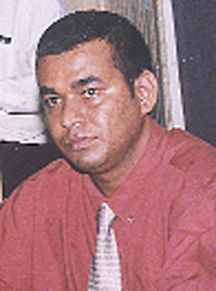Minister of Natural Resources and the Environment, Robert Persaud, yesterday outlined several changes that will be implemented in the sector during a meeting with stakeholders as the newly-established ministry moves to devise a strategic plan for the sector.
Interest in Guyana’s natural resources has been significant in recent times particularly with high prices for gold, increased attention for forests in view of climate services and high interest in petroleum. Minister Robert Persaud told the gathering at the Plaza Hotel that there have been lots of changes taking place in the natural resources sector and at yesterday’s session the newly-established ministry hoped to get specific ideas as to how to better discharge its functions consistently.

The new ministry, according to an overview, was established to have responsibilities for forestry, mining, environmental management, wildlife, protected areas, land use planning and coordination, and climate change. Agencies under the purview of the ministry are the Guyana Forestry Commission, the Guyana Geology and Mines Commission (GGMC), the Guyana Gold Board, the Guyana Lands and Surveys Commission, the Wildlife Management Authority, the Environmental Protection Agency, the National Parks Commission and the Guyana Protected Areas System.
Persaud highlighted some of the significant events in the sector. He said that oil company, Repsol is in the processing of finalizing the anchoring of its rig for drilling for oil offshore Guyana which should commence by the end of this month. The well will take six months to drill. Canadian oil explorer, CGX, is also moving a rig to drill in its block offshore Corentyne.
With regard to gold, he said the sector continues to be plagued by under declaration of a significant amount while also referring to smuggling of the precious metal. He said losses to Guyana as a result of this are great and he charged that there can be the best enforcement but in the end “it is the responsibility and morality” of the sector to ensure that there is compliance with the laws. While Persaud gave an estimate of what the country is losing as a result of the leakages, former commissioner of the GGMC, William Wolford said that since 1988, the technical staff of the agency was doing calculations of what production should be. He said that one of the biggest problems is that miners are not getting more than 50% recovery of in their operations.
In bauxite, the two companies operating here, Bosai and Rusal have lots of plans for expansion of their operations, the minister said.
How to manage conflicts in an expanding environmental is also critical while focus will also be on retooling and developing greater capacity, Persaud said. In this regard, he disclosed plans for a mining school. In addition, according to the minister, it has been estimated that in another seven to ten years, “surface gold” would be exhausted. “There are many, many issues that are before us,” said Persaud.
He said an inclusive approach will be taken as a strategic plan for the natural resources sector is formulated. He noted the Low Carbon Development Strategy (LCDS) but said that this will be more specific.
The ministry was lauded by several participants for its stated approach even as it was noted that more specific sub-sector consultations will follow.
Conservationist Sydney Allicock said it was extremely important to address land claims by indigenous peoples of Guyana moreso in Regions One, Seven and Eight. The people are not truly benefiting from the land allocation, he said, while making reference to mining claims overlapping Amerindian land. This point was also raised by APNU co-leader, Dr Rupert Roopnaraine who made reference to complaints by leaders of Isseneru last week that miners continued to work their land despite the GGMC issuing cease work orders to the miners.
In response, Persaud said that land demarcation and titling is a priority but noted that this exercise is constrained by limited resources while also noting that some matters were in court. He said that government intends to be very strict in enforcement and will be pursuing the Isseneru matter in greater detail.
Jeweller, Dominic Gaskin raised the issue of value-added in the jewellery industry positing that this is the way to go and Persaud challenged the miners to get involved in this aspect.
Environmental consultant Charles Ceres emphasized the importance of sound science for policymaking. In this regard, he highlighted that the science in the LCDS needs to be looked at even as he identified what he described as a “fatal flaw” in the document. He raised several ideas that he said should be examined, including risk assessments. Persaud said that there were extensive consultations on the LCDS and invited Ceres to meet him for clarifications.
Raymond Alli floated the idea of a committee to investigate corrupt officers even as he outlined his experiences. The minister in acknowledging the concerns said they were also looking at the creation of an inspectorate outside the GGMC that will investigate various matters in the sector. He also said that the sector “will be getting a lot of foreign help” in a number of areas.
President of the Guyana Gold and Diamond Miners Association, Patrick Harding, said miners have committed to operate in an environmentally friendly manner. He said the industry is poised to take off and miners now have to be trained and mechanisms must be put in place for this. “We now have to educate our miners,” he said. “We can only do that if we have the support of the government agencies.” He pledged that miners would put things in place to protect the environment and continue to mine and said they would like to discuss with the GGMC as to how illegal mining can be curbed. Those operations, he said, contribute in large part to the destruction of the environment.




